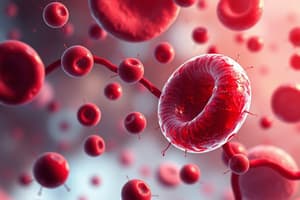Podcast
Questions and Answers
What is the term for abnormally low production of leukocytes (WBCs)?
What is the term for abnormally low production of leukocytes (WBCs)?
- Leukemia
- Leukopenia (correct)
- Leukocytosis
- Aldosteronism
Which hormone decreases the level of calcium in the blood?
Which hormone decreases the level of calcium in the blood?
- Prolactin
- Thyroid-stimulating hormone
- Aldosterone
- Calcitonin (correct)
What is the opposite of aldosterone in terms of sodium and potassium regulation?
What is the opposite of aldosterone in terms of sodium and potassium regulation?
- Thyroid-stimulating hormone
- Adrenocorticotropic hormone
- Atrial natriuretic peptides (correct)
- Growth hormone
Which pituitary hormone stimulates the release of thyroid hormones?
Which pituitary hormone stimulates the release of thyroid hormones?
What is the term for the condition characterized by increased body weight due to sodium and water retention and a low blood potassium concentration?
What is the term for the condition characterized by increased body weight due to sodium and water retention and a low blood potassium concentration?
Which blood type can be safely transfused into a person with Type O Blood?
Which blood type can be safely transfused into a person with Type O Blood?
What determines an individual's blood type?
What determines an individual's blood type?
Which hormone stimulates the contraction of smooth muscle cells of the uterus and causes mammary gland myoepithelial cells to release milk?
Which hormone stimulates the contraction of smooth muscle cells of the uterus and causes mammary gland myoepithelial cells to release milk?
What is the primary reason why a person with Type A blood cannot safely receive blood from a person with Type B blood?
What is the primary reason why a person with Type A blood cannot safely receive blood from a person with Type B blood?
Which of the following stem cells gives rise to lymphocytes?
Which of the following stem cells gives rise to lymphocytes?
What is the function of a receptor in hormone signaling?
What is the function of a receptor in hormone signaling?
What is the role of cAMP in hormone signaling?
What is the role of cAMP in hormone signaling?
What is the primary function of lymphocytes?
What is the primary function of lymphocytes?
What is the final step in the clotting process?
What is the final step in the clotting process?
What is the difference between the extrinsic and intrinsic pathways of blood clotting?
What is the difference between the extrinsic and intrinsic pathways of blood clotting?
What is the role of prothrombinase in the clotting process?
What is the role of prothrombinase in the clotting process?
Flashcards are hidden until you start studying
Study Notes
White Blood Cells (WBCs)
- Leukopenia: abnormally low production of leukocytes (WBCs)
- Leukocytosis: elevated levels of leukocytes (WBCs)
- Leukemia: abnormally high levels of leukocytes (WBCs) - cancer of the white blood cells
Hormones
- Calcitonin: lowers the level of calcium in the blood
Aldosteronism
- Characterized by increased body weight due to Na+ and water retention and a low blood K+ (potassium) concentration
- Aldosterone: regulates sodium, retrieves sodium from urine, and puts potassium into urine
- Atrial natriuretic peptides (opposite of aldosterone): puts sodium into urine and retrieves potassium
- Sodium is water-loving, water follows in either direction of potassium
Pituitary Hormones
- Thyroid-stimulating hormone (TSH): releases thyroid hormones
- Adrenocorticotropic hormone (ACTH): releases steroid hormones from adrenal cortex
- Follicle-stimulating hormone (FSH): promotes ovarian follicle development in females, secretes estrogen, and promotes maturation of sperm in males
- Luteinizing hormone (LH): induces ovulation, secretes estrogen and progestins in females, and stimulates production of androgens/testosterone in males
- Growth hormone (GH): stimulates cell growth and reproduction by stimulating rate of protein synthesis
- Prolactin (PRL): stimulates mammary gland development and milk production
- Melanocyte-stimulating hormone (MSH): stimulates melanocytes of skin to increase melanin production
- Antidiuretic hormone (ADH): decreases water loss from the kidney, causes vasoconstriction
- Oxytocin (OXT): stimulates contraction of smooth muscle walls of the uterus, causes mammary gland myoepithelial cells to release milk
Blood Typing
- Blood type is determined by the surface antigens on RBCs
- Only Type O blood can be safely transfused into a person with Type O Blood
- A person with Type A blood cannot safely receive blood from a person with Type B blood because of anti-B antibodies in the plasma that attack Type B surface antigens
Blood Cell Formation
- Cells are made in the red bone marrow from a hematopoietic stem cell
- Hematopoietic stem cell turns into lymphoid stem cells or myeloid stem cells
- Lymphoid cells produce lymphocytes
- Myeloid cells produce all formed elements, except lymphocytes
Hormone Response
- Cells only respond to hormones if they have a receptor
- Proteinaceous hormone receptors must be on the outside of the cell and turn into peripheral proteins on the inside of the cellular membrane (G protein)
- Activated receptor triggers adrenaline cyclase, which takes ATP and creates cAMP, the second messenger
First and Second Messengers
- First messenger: relays messages to an intracellular intermediary
- Second messenger: affects enzyme activity and changes cellular metabolic reactions (e.g., cyclic-AMP or cAMP)
Lymphocytes and Immune Response
- Lymphocytes are part of specific defenses and respond to specific antigens
- They develop a stem cell line that allows them to respond again by making antibodies or attacking directly if they see the antigen again
Blood Clotting
- There are two pathways that lead to the common pathway: extrinsic and intrinsic
- Extrinsic pathway: begins with release of tissue factor (Factor III) from endothelial cells or peripheral tissues
- Intrinsic pathway: begins with proenzymes exposed to collagen fibers at the injury site
- Both pathways lead to the common pathway: activated Factor X forms prothrombinase, which converts proenzyme prothrombin to the enzyme thrombin, which converts fibrinogen to fibrin (completion of clotting process)
Studying That Suits You
Use AI to generate personalized quizzes and flashcards to suit your learning preferences.




